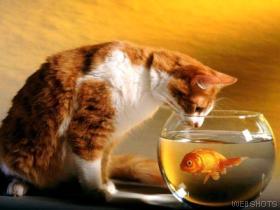What Should You Really
Feed Your Cat?
The Simple Explanation
Your cat's "metabolism" is the food processing and energy production system of their body. It is made up of extremely fine-tuned internal processes.
Fortunately, your cat's body has miraculous healing powers, is very resilient and operates in a very intelligent manner. If you give your cat the right fuel and the right nutrients, he or she will respond very quickly. Some exercise also helps!
One of the most important things to get correct is what your cat eats.
Buying Commercial Food
There is a huge variety of cat foods on the market and you need to know which ones are good to feed your cat. All cats are carnivores, like lions and tigers, and their body is designed the same way even though they are domesticated. So feeding your cat the appropriate food is very important to your cat's overall health and nutritional needs.
Domestic cats will normally eat 4 to 6 ounces of food a day, some may eat more.
You DO NOT want to feed your cat ANY food that contains any of the following ingredients within the first 5 ingredients on the label:
| corn (meal) |
sorghum |
| rice (any type) |
potato (any type) |
| wheat |
carrots |
| barley |
beets |
| rye |
peas |
| oats |
yams |
| beans of any kind |
|
| |
| Including the flour or meal from any of the above ingredients. You will see that dry food contains a lot of these ingredients. |
Cats in the wild never eat these ingredients because they are carnivores and only eat other animals.
Big cats in the zoo are never fed these ingredients. Their good health is maintained by a 100 percent raw meat diet.
Below are two links to wet canned cat food lists. These lists show the percent of protein, fat and carbohydrate contents of the various kinds and types of canned cat foods.
Try to use the canned foods which have 0 percent grams of carbs. If there are not enough flavors available in your area, you can use the canned foods that are as high as 3 percent grams of carbs.
Here are the links for these two lists:
Remember, you also want to mix in with the wet food about 25 percent (25 percent of the portion size) shredded green vegetables such as: broccoli, spinach, Brussels sprouts, green lettuce, string beans, green peppers, snow pea pods, kale, etc. (excluding green peas), for needed fiber and roughage.
Just chop it by hand, or in a food processor, or blender and mix it in with the food.
Many cat foods contain "by-products" instead of real meat, you may wish to feed your cat a higher quality food which are also on these lists.
The closer you bring your cat's diet to what it would normally be if it were living in fields or forests, the fewer will be the health issues its body will have to face as it grows older.
Making Your Cat's Food
The problem with all canned or dry pet food is that they do not list carb content on the can or on the bag, and so you are left with just looking at the ingredients list. The further down that list the non-animal protein ingredients appear, the better the chance of the total content being lower in carbohydrate. But this is an approximation at best.
A solution to all this guesswork is to make your pet food at home, which is easy. Just get ground beef or ground lamb, add in the shredded greens (raw) and you have instant high quality pet food. You do not have to worry about additives, there are no animal "by-products," and most important, it has almost no carbs.
Do not use lean beef, use the 15 to 20 percent fat, as the fat is needed for the production of hormones in the body. You can also use ground chicken or turkey, but as these are leaner meats, you will need to ask the butcher to add some chicken fat and chicken skin to be mixed and ground in with the meat, to raise the fat content.
Ideally the food is served completely raw, but the meat can be cooked, and then gradually cooked less and less till it is being served raw. Raw meat is easier to digest and has hundreds of live enzymes that bring improved health. These enzymes are destroyed by being cooked or frozen.
Transitioning Your Cat From Dry to Wet Cat Food
One reason that cats like dry food so much is because the pet food companies spray the kibble with liquified animal entrails which are very pleasing to a cat’s sense of taste and smell - making a terrible diet very desirable to your cat.
Another issue is that dry food has a crunchy texture which is very different from canned food. Some cats may resist that change in the texture of their food.
This site suggests some excellent ways of transitioning your cat if your cat doesn’t take to wet food right away.
Here is the link:
http://www.catinfo.org/#Transitioning_
Dry_Food_Addicts_to_Canned_Food

